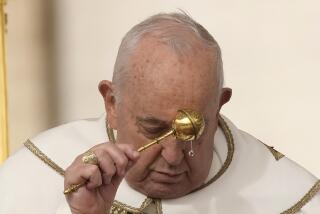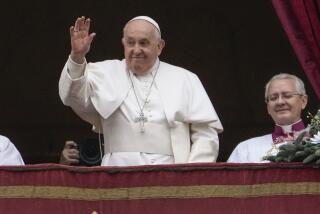60 Religious Leaders Join Pontiff : Streets of Assisi Ring With Prayers for Peace
- Share via
ASSISI, Italy — Carrying olive branches and offering prayers, Pope John Paul II and the representatives of the world’s religions, including a Crow Indian medicine man from Montana and an African animist witch doctor, pledged Monday to work for peace.
As 60 religious leaders joined the Pope in this picturesque medieval hill town where St. Francis preached 700 years ago, governments and rebels throughout the world put down their arms briefly in response to a papal call for a cease-fire and a day of prayer.
Separate Prayers
The Pope urged the interdenominational conclave to meet “the dramatic challenge of our age--true peace or catastrophic war.” The Dalai Lama, the exiled Buddhist god-king of Tibet, said the historic gathering of religious figures offered proof of the “indispensable spiritual dimension” in efforts to end war.
Although the religious leaders joined in fasting and appealing for world peace, they prayed separately--out of respect, they said, for one another’s divergent religious beliefs.
During the prayers here, the Vatican announced that many warring guerrilla groups and governments had answered the Pope’s call of three weeks ago for at least a one-day cease-fire during the day of prayer.
Warring parties in a dozen countries, including Nicaragua, El Salvador and Cambodia, heeded the Pope’s appeal and observed a cease-fire. Among those laying down their arms, Vatican spokesman Joaquin Navarro-Valls reported, were guerrilla groups in Angola, Sudan and Western Sahara, and all but one of the insurgent forces in Latin America--the Sendero Luminoso, or Shining Path group of Peru, a far-left band that espouses the theories of the late Chinese leader Mao Tse-tung.
Elsewhere, the Pope’s plea for peace was ignored. President Saddam Hussein of Iraq had written the Pope that he would observe a truce if the Iranians did not attack his forces. But broadcasts from the Persian Gulf indicated that Iraqi planes flew over Iran, and Iran claimed to have shot one of them down.
Bombing in Northern Ireland
In Newry, Northern Ireland, a bomb derailed a freight train and severed the main rail line between Belfast and Dublin. No one was hurt in the attack, which authorities suspected was the work of the Irish Republican Army, fighting to drive Britain from mostly Protestant Northern Ireland.
Five Tamil guerrilla groups and the government of Sri Lanka agreed to call off their hostilities for the day, but the government later accused the Tamils of violating the truce by killing a soldier at an army camp in the rebels’ northern stronghold of Jaffna. The Liberation Tigers of Tami Eelam, the major rebel group seeking an autonomous state, said government troops rounded up and tortured 23 civilians.
More than half of the participants in the day of prayer here were Christians, including representatives of the sometimes-aloof Russian, Bulgarian, Romanian and Czechoslovak Orthodox churches, as well as representatives of most of the world’s major Protestant groups.
Among the best-known figures were the Dalai Lama, representing Tibetan Buddhism, and Robert A. K. Runcie, the Archbishop of Canterbury, who is head of the Church of England.
The religious groups represented here claim about 3.5 billion adherents worldwide--or 70% of the world’s population, the Vatican said.
As the leaders dispersed to their private places of prayer--in the churches, plazas and public buildings of this town that calls itself “the city of peace”--it was the more esoteric religions that drew the largest crowds of onlookers from among the unexpectedly small number of visitors who came to Assisi.
Perhaps the most sought-after was John Pretty-On-Top, of Montana, whose Roman Catholic nephew, Burton Pretty-On-Top, described him as a medicine man and healer of the Crow American Indian tribe. Both Pretty-On-Tops were dressed in full ceremonial regalia, including beaded buckskins and elaborately feathered headdresses.
As part of his private prayer ceremony in the small church of San Gregorio, the elderly medicine man blessed spectators who volunteered to join his ceremony by laying a ritual fan of feathers on their heads and chanting an American Indian prayer in the Crow language.
At the altar of the one Zoroastrian--a Bombay Indian believer in the ancient fire-worshiping religion of Persia--a young Italian woman volunteer periodically fed modern charcoal igniter pellets to the sacred iron brazier that was the focus of his prayers for peace.
An African animist snake worshiper the Pope met last year on a visit to Togo appeared to be ill at ease as he delivered a staccato prayer to “Almighty God, The Great Thumb,” from a platform in Assisi’s Renaissance city hall.
In his prayer, the witch doctor cursed “all the wicked persons who frustrate this laudable effort made to achieve peace,” and added, “Let all the evil ancestors and spirits receive their drink and flee to their doom.”
Buddhists beat drums to accompany their prayers, Shintoists from Japan played reedy bamboo instruments, Hindus read from the Upanishads and Sikhs chanted in a smoke-filled room during the several hours of private time each religion was allocated to make its own prayers for peace.
A Jainist, representing a faith that was started in the 6th Century BC as a protest against Hinduism--its followers respect life to the extent that they sweep the path ahead of them to avoid stepping on any creatures--prayed alone in the square outside the bishop of Assisi’s historic palace.
“All beings desire to live,” the Jainist prayed. “None desires to die. Killing is therefore terrifying.”
After several hours of prayer apart, the religious leaders walked in silent processions to a plaza in front of the 800-year-old Basilica of St. Francis, whose peaceful ways in the 13th Century made Assisi famous and inspired John Paul to invite the world’s religions to Monday’s day of prayer.
There, in a moving climax to the day’s events, the participants raised olive branches in a commitment “to make peace a central aim of our prayer and action.”
Representatives of each group--Christians, Jews, Buddhists, Bahais, Hindus, Muslims, Sikhs, animists, American Indians, Shintoists, Zoroastrians and Jains--mounted the podium one after another and offered public prayers.
John Paul had specified beforehand that the leaders come “together to pray for peace, not to pray together,” in order to avoid even a suggestion that any one faith would try to impose itself on another.
The pontiff was unabashedly Christian and Roman Catholic, though, when he delivered his own prayer on behalf of the Christians present, professing his conviction “that in Jesus Christ, as savior of all, true peace is to be found, ‘peace to those who are far off and peace to those who are near.’ ”
‘Challenge of Peace’
Taking note of the day’s diverse prayer ceremonies, he said, “The form and content of our prayers are very different, as we have seen, and there can be no question of reducing them to a kind of common denominator.”
But he added that “the challenge of peace, as it is presently posed to every human conscience, transcends religious differences.”
The pontiff also confessed “that Catholics have not always been faithful to this affirmation of faith. We have not always been ‘peacemakers.’ ” As a result, he said, Catholics and perhaps all the others as well came to Assisi on Monday as “an act of penance.”
But it was the American medicine man, John Pretty-On-Top, who moved the audience of about 2,000 in the plaza to thunderous applause when he lifted his smoking peace pipe and prayed:
“O Great Spirit, I raise my pipe to you, to your messengers the four winds, and to Mother Earth, who provides for our children. Give us the wisdom to teach our children to love, to respect and to be kind to each other, so that they may grow with peace and mind. Let us learn to share all the good things that you provide for us on this earth.”
Only one woman, Susannah Telewoda of Barbados, a Lutheran, spoke as a representative of a religious faith. There were four other women among the participants, including Mother Teresa of Calcutta, the Noble Peace Prize-winning nun.
At the request of the Buddhist delegation, all participants fasted until sunset. Then the 60 religious leaders and about 90 of their co-religionists joined a group of Franciscan friars in the monastery of St. Francis for a simple banquet at which Assisi city officials presented each with a large bronze medallion depicting two hands gracefully releasing a dove of peace.
Also among those attending were Ahmed Shehati, a Muslim, the deputy foreign minister of Libya; Rajmohan Gandhi of India, a nephew of the late Indian independence leader Mohandas K. Gandhi, representing the Hindu religion; Muneyoshi Tokugawa, the chief Japanese Shinto priest, and Elio Toaff, the chief rabbi of Rome.
Southland religious leaders observe papal peace day. Page 9.
More to Read
Sign up for Essential California
The most important California stories and recommendations in your inbox every morning.
You may occasionally receive promotional content from the Los Angeles Times.










